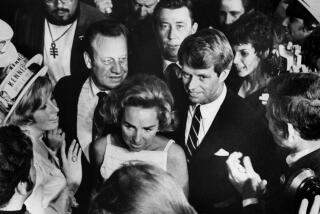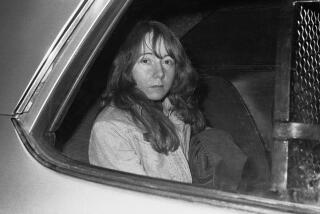Clinton, Gore Invoke Imagery of the Kennedys
WHEELING, W. Va â In his bid to appeal to voters as a candidate of the future, Democratic presidential nominee Bill Clinton is playing heavily on the imagery of the past--specifically, on the mythologized image of his partyâs 1960 candidate, John F. Kennedy.
For the past two days, the Arkansas governor and his running mate, Tennessee Sen. Al Gore, have walked in footsteps left by the late President Kennedy 32 years ago.
As the sun set Saturday night in the old steel town of McKeesport, Pa., they stood under a jaunty statue of the late President, built in Kennedy Park on a site he visited during his presidential campaign.
Sunday morning, they hit West Virginia, where Kennedy turned around his presidential campaign with a victory in the stateâs 1960 primary. At the Weirton Community Center, where John Kennedy had spoken to townspeople and where his brother Robert came in November, 1965, to dedicate a bust of the assassinated President, Clinton summoned the memories.
âIn 1960 that man, John Kennedy, came here to this place and said itâs time to change and thatâs what I say to you,â Clinton said, pointing at the Kennedy memorial.
âWe have not met the challenge of this new age. We have won the Cold War . . . but weâre losing the peace because we have refused to change, to do what it takes to compete and win in a tough world economy, and weâre going to do that. . . .â
Halfway through their six-day, 1,004-mile bus tour from New York to St. Louis, Clinton and Gore have been doing their best to look like a â90s version of John and Robert Kennedy, tossing around a football for the television cameras and jogging after church Sunday morning.
Sunday in West Virginia, where Democrats have long held sway politically, they toured a steel mill, posing in the hot orange glow of molten ore. After a stop in Wheeling, where Clinton taped a cable television show, the candidates headed to Ohio, where they spent the evening at a Utica farm, owned by the stateâs Democratic party chairman.
At the carefully staged farm appearance, Clinton told about 60 people that he would work to save the family farm. âAl Gore and I represent a better future,â he said, standing in a muddy patch of soil. âWeâve already gotten you rain since I was nominated.â
While the locations were ever-changing as Clinton and Gore moved west by bus, the image was consistent--they were meant to be seen as vigorous and exciting. Indeed, they were met at virtually every stop by voters squealing as if they were witnessing the arrival of a rock band.
While the exuberant response buoyed the candidates and their wives, Hillary Clinton and Tipper Gore, Clinton used the occasion to deliver a warning.
âIn the weeks and months ahead, America will be put to the test,â he said. âAl Gore and I will ask you to vote for the future and vote for change. Our opponents will tell you that everythingâs going to be all right and keep it the way it is.
âTheyâll try to frighten you about us. . . . Theyâll tell you that weâre too liberal and weâre too young and weâre too this and weâre too that and weâre too the other thing.
âIâll tell you what--weâre too much (on the side of) the American people for their tastes.â
While Clinton is clearly hoping for a positive comparison with Kennedy, he runs the risk that voters will find him wanting compared to Kennedy. Vice President Dan Quayle found out in a 1988 debate with Democratic vice presidential nominee Lloyd Bentsen that casting oneâs self in the image of an assassinated leader can be troublesome.
âSenator, I knew Jack Kennedy. Jack Kennedy was a friend of mine. And senator, youâre no Jack Kennedy,â said Bentsen, in a line that outlived the campaign.
Clinton, however, has had his path smoothed by Kennedyâs own allies. At McKeesport, for example, Pennsylvania Sen. Harris Wofford, a founding member of Kennedyâs Peace Corps, asserted that crowds as large as those greeting Clinton and Gore had not been seen since the Kennedy visit.
âWe donât know everything that John Kennedy would have done had he got a chance,â Wofford told more than 1,000 people who lined the park to see Clinton. âBut he was cut down, and now we pass the torch to a new generation of Democratic leaders. One thing I do know--if John Fitzgerald Kennedy was here today, he would say: âI ask you to make Bill Clinton and Al Gore the next President and vice president of the United States.â â
The image-making was so pronounced that one member of the audience stood to ask Clinton what he thought about the Warren Commissionâs determination that President Kennedy was shot by Lee Harvey Oswald, acting alone.
Clinton passed the question to Gore, who reminded the townspeople that recently a House committee had concluded that Kennedy was killed by a conspiracy of unknown origin.
âI believe that,â Gore said. âI think most Americans believe that.â
Clinton agreed with Goreâs contention that federal files held secret since the Kennedy assassination should be opened to the public. But he backed away from Goreâs pronouncement of support for the conspiracy theory.
âMy opinion is slightly less formed,â Clinton said. âI donât know whether Lee Harvey Oswald acted alone or not, but I know there are a lot of questions that the American people donât have answers for.â
The Kennedyesque image that Clinton is attempting to cultivate has paid him benefits in the areas where the late President is still revered. In Weirton, W. Va., for example, Peggy Petrella stood outside the community center and tried to catch a glimpse of Clinton, much as she had stood outside in 1965 when Robert Kennedy came to town.
âWe were at a standstill in 1960 and we are certainly at a standstill now,â she said, noting comparisons between the two men.
Clinton and Goreâs efforts have drawn fire from Republicans, who have asserted that the two are not moderates in the John Kennedy mold but unabashed liberals.
Coming back from jogging on Sunday morning, Clinton and Gore brushed aside the criticism.
âIt shows how impoverished they are,â Clinton said. âThey have nothing to say to America. Nothing to be for, no record to run on, no vision of the future.â
He added later: âItâs a knee-jerk thing. You know, itâs almost like they have to have some sort of inoculation or a shot to get over that.â
More to Read
Get the L.A. Times Politics newsletter
Deeply reported insights into legislation, politics and policy from Sacramento, Washington and beyond. In your inbox three times per week.
You may occasionally receive promotional content from the Los Angeles Times.











